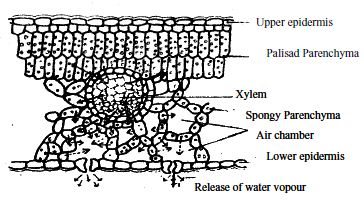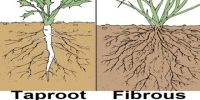Stomata are present on the leaf, usually on the ventral surface. At the upper epidermis of dorsiventral leaves there is palisade parenchyma and at the lower epidermis, there is spongy parenchyma. In spongy parenchyma, there are many air spaces. Stomata are present near the airspace and placed in the lower epidermis. Usually vascular tissues i.e. xylem and phloem are present at the connecting zones of Palisade and Spongy parenchyma.
Root hairs absorb water from the soil and reach to the leaf through stem by vessels and Tracheids of xylem tissue. On reaching leaf the water comes out of the xylem tissue and spread throughout all the cells of the leaf. The outer walls of the spongy parenchyma always remain wet to absorb carbon dioxide (CO2), necessary for photosynthesis.

The air inside the airspace of spongy parenchyma come in contact with water of spongy parenchyma and absorb water vapour and store in the air spaces behind the stomata. Later on, the vapour comes out to the atmosphere through the open stomata. Air, O2 and CO2 also move through open stomata. In most plants, stomata remain open during the daytime and closed in the night. In succulent plants stomata remain open at night and closed in the daytime.
As a result of photosynthesis the carbohydrates inside the guard cells converted to soluble glucose and the guard cells absorb water from adjacent cells and become turgid and the stomata open. During night. the soluble glucose converted to insoluble carbohydrate, the guard cell loose water to the adjacent cells by exosmosis and become flaccid. As a result, the stomata close. For this reason, transpiration takes place in the daytime.











